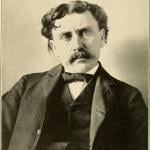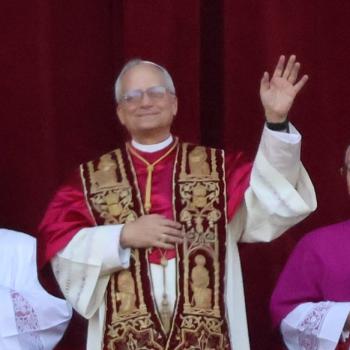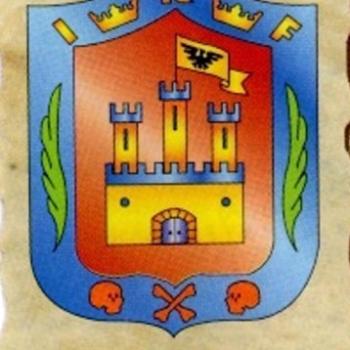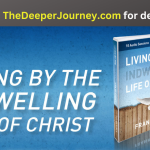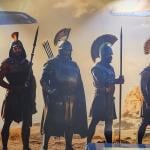“To go on pilgrimage is not simply to visit a place to admire its treasures of nature, art or history. To go on pilgrimage really means to step out of ourselves in order to encounter God where he has revealed himself, where his grace has shone with particular splendour and produced rich fruits of conversion and holiness among those who believe.” – From the Address of the Holy Father Benedict XVI on November 6, 2010 during his Apostolic Journey to Compostela and Barcelona
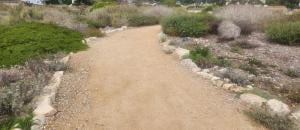
A gravel path. Photo by author.
I have always wanted to walk the Camino de Santiago Compostela. As a historian, I’ve studied and taught the history of Spain and New Spain for decades. I even lived in Sevilla for three months on a funded research trip during which I traveled around the central and southern region and experienced Semana Santa, but as a poor graduate student, I could not afford the long journey north.
So it was with great joy that last Saturday, my family and I participated in “Along the Way: A Pilgrim Walk,” organized by a local Catholic retreat house, a morning event designed to replicate the spirit of the Camino, a Caminito, if you will. For this post, I’d like to reflect on the experience and on the larger practice of Christian pilgrimage.
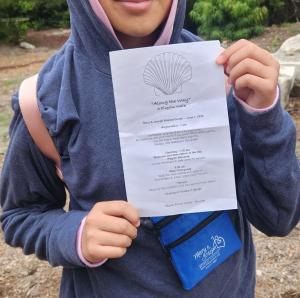
The author’s daughter holding up the event schedule. Photo by author.
The morning was brisk and foggy when we arrived, not quite sure what to expect. At a registration table we each received a little blue stringed pouch with our names printed on an insert, and an invitation to write our intention for the walk on a little slip of paper. It was a wonderful opportunity to speak with my children about the many reasons Christians might embark upon a pilgrimage – as an act of penance, an act of thanksgiving, an act of petition, an act of reflection, or as an opportunity to open our hearts to hear God’s voice, to seek stillness in movement.
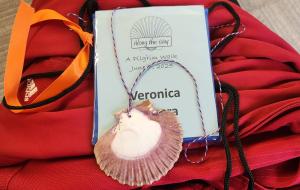
My little blue stringed pouch, shell, and orange group ribbon. Photo by author.
After gathering near the labyrinth to hear a brief history of the Camino de Santiago Compostela, we learned that pilgrims would stop by the beach for a shell as proof of their walk, hence its association with el Camino. Joining the Spanish-speaking group, my family followed our assigned “shepherd” to a nearby table where we received a traditional pilgrim’s blessing from a deacon who had himself walked the Camino and had in hand the walking stick he brought back from Spain. After taking a moment to call to mind the intention for our pilgrimage – and then being doused with holy water – we ambled down the hill to follow the sidewalk, guided by little blue and yellow signs with conch shells, just like along the Camino, someone told me.
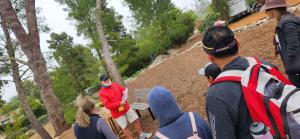
Receiving the pilgrim’s blessing. Photo by author.
The retreat house is on the property adjoining my children’s school, so I knew these streets well. Walking familiar sidewalks in a meditative state, focusing on our steps, on our thoughts, rather than rushing by to get to school or Mass on time, was a good reminder that we can make any walk our own little Camino.
We arrived at a station with two volunteers who stamped our passports and read from Matthew. Highlighting the burdens we carry as we journey through life, they reminded us that Christ said our burdens would be light; He didn’t say we would not have burdens. Holding open a bag of rocks, the volunteers asked us to reach in without looking and “pick a rock or allow a rock to pick us.” I pulled out a smooth, black stone and my older son said that it suited me, for it resembled the obsidian I’ve found in Mexico and reflected that I study Mexican history; I liked his interpretation. When my 7-year-old pulled out a beige stone with darker veins of beige running through it, he immediately said he wanted to keep it; he put it in his pocket, while carefully balancing a snail in his other hand. My 9-year-old-son decided to leave his own snail behind and focus on his shiny, black stone. Before the group walked on, the volunteers told us that these small stones represented the lightness of our burdens when we walked with Christ.
We entered a neighborhood and rounded a corner to our second stop. Here, two volunteers read another Scripture passage, then explained that when we go on pilgrimage, we should not pack our fears. To that end, they invited us to write our greatest fear on a piece of paper and deposit it into a Camino de Santiago Compostela-emblazoned bag, symbolically leaving our fears behind as we stepped onto a rocky public trail along the bluff overlooking the ocean.

The author’s family on the Caminito. Photo taken with author’s phone and used with permission.
Uneven, rocky, and steep, the dirt path reminded us that walking with Christ takes effort and that obstacles in our path – even tiny rocks – might cause us to stumble. If, however, we walk alongside those who are also walking with God, we will have the support we need to keep moving forward when the steepness of the climb tempts us to turn back, go downhill, and return to the paved street where we left our fears. More importantly, someone will be next to us to help us up from a fall.
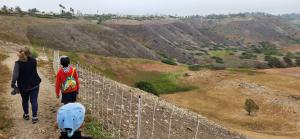
The author’s sons following the group shepherd. Photo by author.
Leaving the path, we returned to the sidewalk, stopping for the fourth station under the shadow of the steeple of our parish church on the corner. Here, we heard more Scripture. Reminding us that the walk was what we made of it, we listened to the account of an Irish pilgrim who traversed the Camino just last month: while walking a narrow footpath, 4 cyclists came barreling along, shouting at the pilgrim to move. With nowhere to go but into the thick overgrowth, the pilgrim kept right on walking, forcing the cyclists to dismount and walk. Rather than allow himself to be affected by the bikers’ frustration, the pilgrim maintained his peace and remained present on the walk. When the path widened, he stepped aside to let the cyclists pass, but when the first one shouted an obscenity, the pilgrim returned to this slow, meditative walk on the path, trapping the remaining three cyclists behind him. Ignoring two or three opportunities to move aside, he finally gave them room to pass. One cyclists said “bien camino” (the traditional Camino greeting), another thanked him, with the final cyclist, overcome with laughter, shouted “¡Que loco peregrino!” Reaching a little cafe on the Camino, the pilgrim noticed the barista staring at him and became uneasy. When he reached the front of the line she said, “¿Loco peregrino?” quizzically and he hesitated before admitting that he was, indeed, the crazy pilgrim. She smiled and handed him a drink and pastry, purchased by the 4 cyclists.
At the conclusion to the story, the volunteers reminded us that the Caminito is what we make of it, and we can achieve peace even in trying situations, even when those around us at not at peace, or are actively trying to disrupt our peace. To that end, they invited us to write our initials on a dove-shaped post it note, then place the note on a poster board with a hand drawn dove.
Our next stop was a little park where two volunteers read us more Scripture, then sent us up a little hill to deposit our “burdens” into a basket at the foot of an iron cross. My children didn’t want to give up their stones, so a volunteer let them choose an extra rock from a jar to leave behind. Is this a sign, perhaps, that my husband and I are providing our children with a happy, burden-free childhood? Maybe. Or maybe they just like shiny, little stones. Ascending the hill, we left our “burdens” in a basket at the foot of an iron cross, pausing to admire God’s beauty before us – the open ocean beyond the bluff.

The author’s husband leaving his stone “burden” at the foot of the cross. Photo by author.
Leaving the park, we turned our steps towards the retreat house, making a fifth stop near the retreat house entrance to hear our final Scripture passage. Laid out on the table were small, flat shells on strings, and the volunteers instructed that we look them over and choose a shell that called to us –then put it around the neck of someone else, saying, “You have arrived. You are enough. Be free.” My daughter turned to my older son as I bent to put the shell over my youngest, saying the words slowly, meaningfully. Then my husband and I stepped toward each other and held one another’s gaze as we took turns placing the shell and saying those powerful words. Like any couple, we’ve had our struggles, several of them prompted by our individual preferences for expressing our Catholic faith. The organizers of this event could have no idea how significant those words or this moment would be for us.

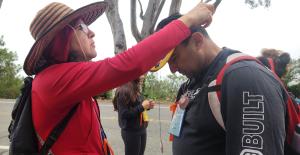
The author and her husband receiving and placing the shell. Photo by author’s daughter with author’s phone.
.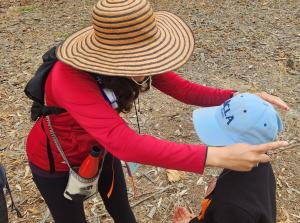
The author placing the shell over her youngest child’s neck. Photo by author’s husband with author’s phone.
I think that is one of the points of pilgrimage – you don’t know what you’ll receive until you make that walk, until you open your heart to God, until you listen and learn from others traveling alongside you, until you embrace the stillness of walking with Christ.
 My fully-stamped passport. Photo by author.
My fully-stamped passport. Photo by author.
At the beginning of the day, the event organizers told us that anyone wishing to walk the Camino de Santiago must fill out a questionnaire that offers three options for making the pilgrimage – 1) religious, 2) spiritual, and 3) other. At the end of the Camino, pilgrims answer a similar question about why they did the walk, and a significant number who initially checked “other,” described their pilgrimage as spiritual or religious.
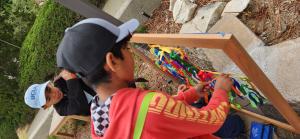
The author’s children tying their Camino ribbons to the cross at the end of the prayer walk. Photo by author.
That is the power of the pilgrimage. Even if you know your destination, you might arrived somewhere unexpected.


